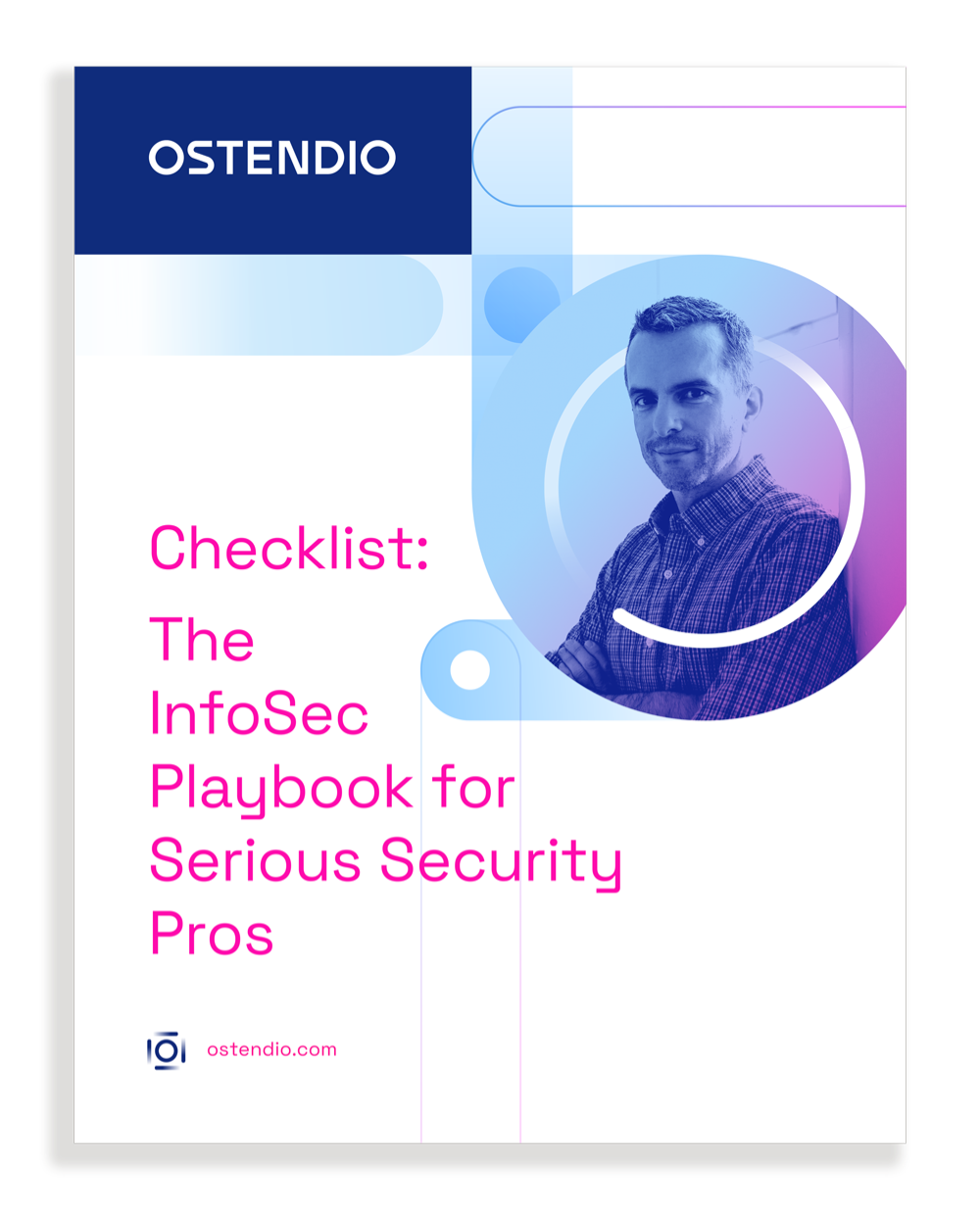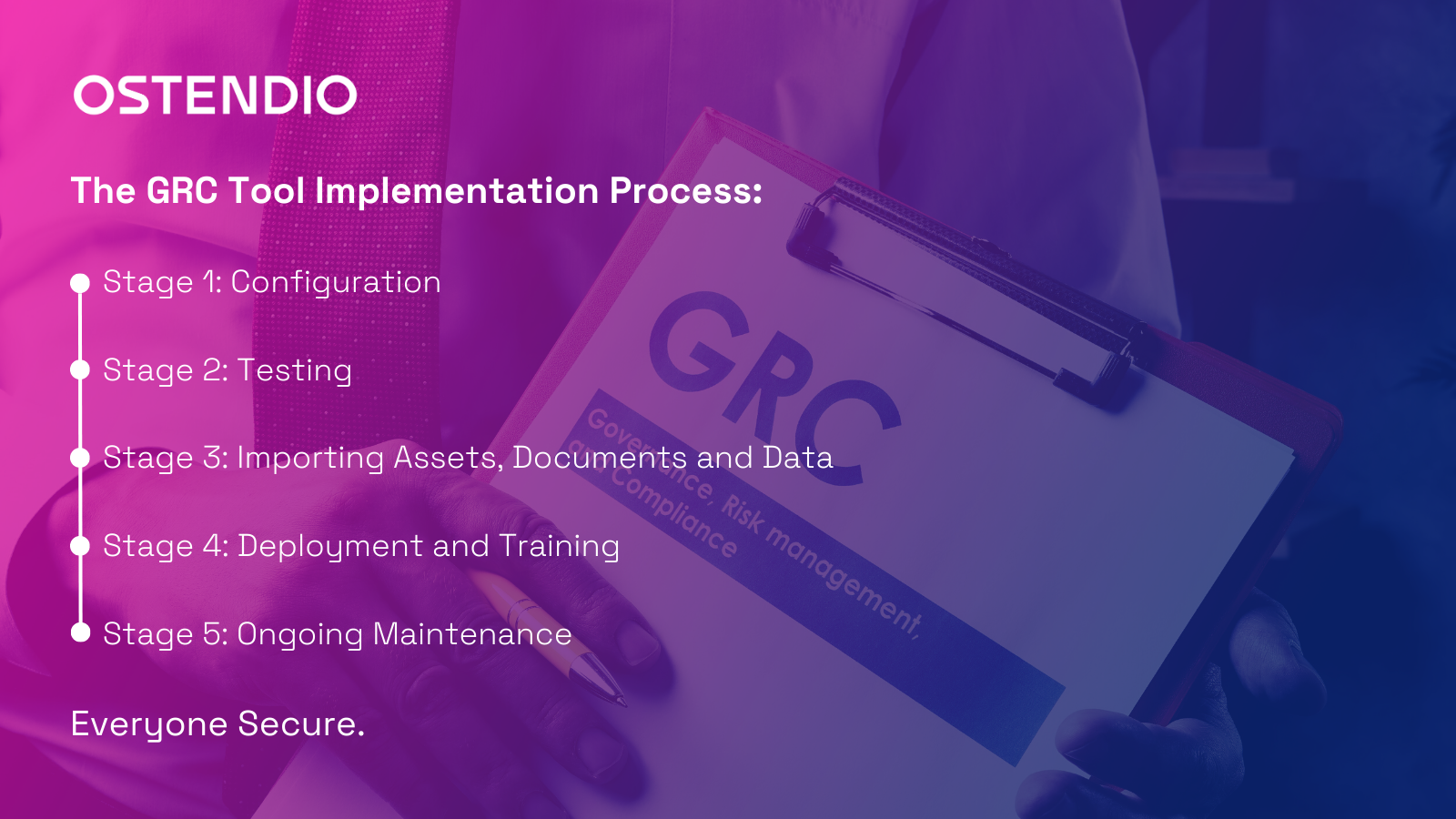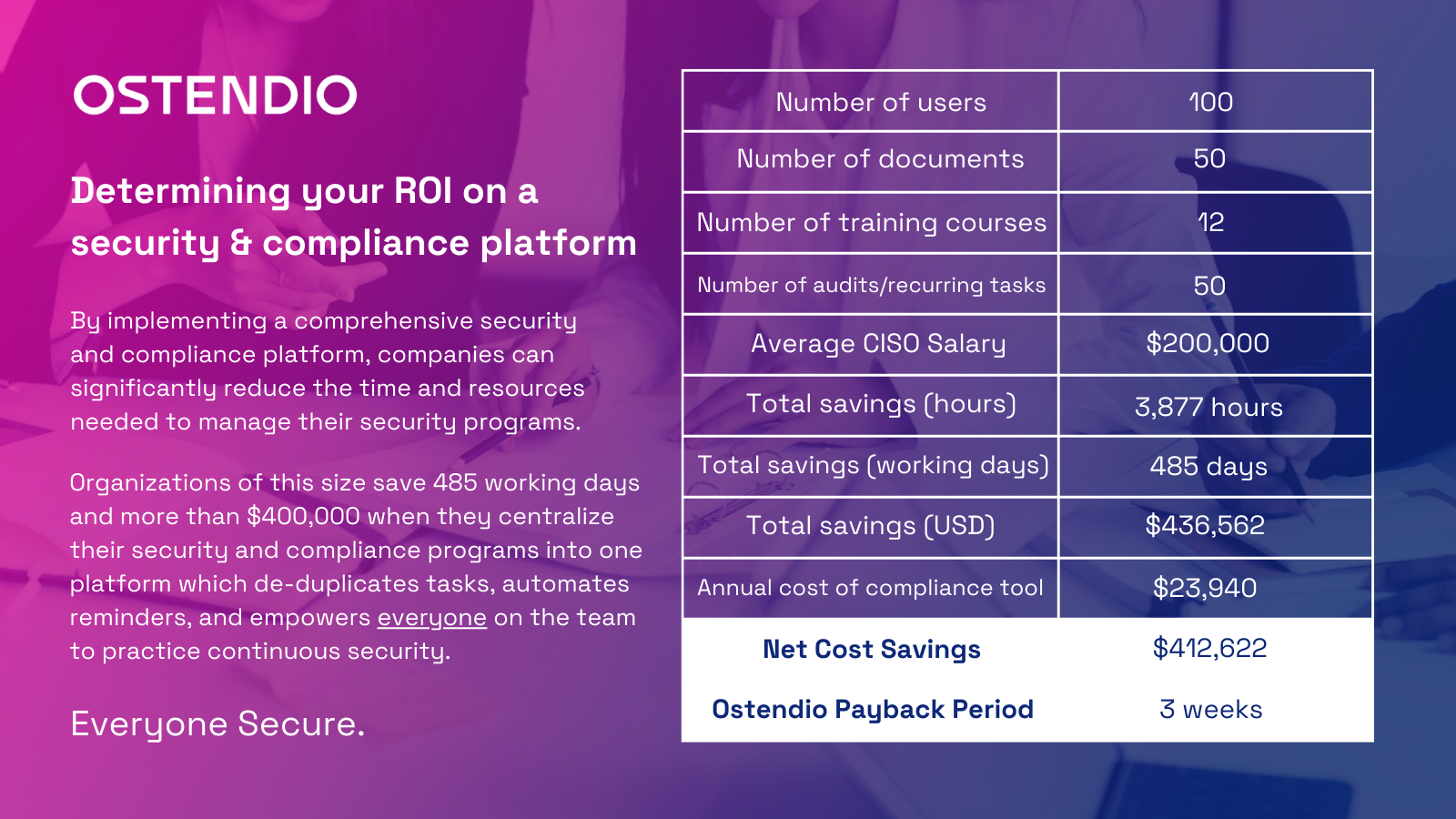GRC Tools: The Buyer's Guide to Scaling Your Security
Governance, Risk, and Compliance (GRC) refers to managing and optimizing an organization's performance in decision-making, risk management, and regulatory compliance.
With a GRC strategy implemented across your organization, you can mitigate risk, improve security, and strengthen trust with your customers, partners and stakeholders. Additionally, you can feel confident that your organization is safeguarded against breaches and bad actors.
A GRC platform enables organizations too properly manage risk and ensure compliance throughout your organization.
As you embark on researching GRC tools for your business, questions may arise such as:
-
How much does a GRC tool cost?
-
Which GRC platforms align with our business practices and security needs?
-
What GRC features will enable our organization to reach our security and compliance goals?
Below is a comprehensive breakdown with answers to these questions, including the benefits of a GRC tool, cost estimations, and features you should consider.
The InfoSec Playbook for Serious Security Pros
Never fall behind on your security tasks
Daily systems monitoring... monthly policy reviews... annual compliance trainings... the list goes on. Download this complete InfoSec checklist to conquer your security tasks like a pro.

Factors to consider while
researching GRC tools
Selecting a GRC tool is not an easy choice. A solution should not only satisfy your budget, but also your risk and security needs as an organization.
Here are some considerations when adding a GRC tool to your techstack:
Features and functionality
Ideally, the software should perform all the necessary GRC functions–risk assessment, compliance management, security and compliance training, documentation management, and reporting.
Tools that go the extra mile to incorporate in-app auditor collaboration, crosswalking capabilities to multiple security frameworks, and action-oriented integrations will get you reduced time-to-value and save you labor hours.
Customizability
Your GRC tool should fit your unique business and security needs. Many GRC tools only provide a cookie-cutter approach to maintaining security and compliance which provide limited value considering no two organizational or security and compliance programs are alike.
Look for a GRC tool that gets you across the finish line by giving you full control of your security and compliance program. This might mean custom templates, integrating to your systems by pulling in richer data, and streamlining your workflows.
User-friendliness
While software should help you meet your goals, it also be easy to use and understand for both technical and non-technical users. As a CISO or security professional, you’ll be working within the program majority of the time, but other departments, from HR and Marketing, to Finance will need to engage as well, so you’ll want to be sure they’re also comfortable with the platform.
Integrations that aren't void of action
A GRC tool should integrate with other systems and tools you have already throughout your organization, but consider what these integrations are doing for your company. You’ll want to do more than just replicate data, but also be able to take action on the data you’re pulling into your GRC system.
Scalability
Consider how your organization’s security and compliance will scale. As you enter new markets, update your product line, or add new employees and technologies , your organization will need a GRC software solution that can handle the current and future needs as you grow and evolve. This means user access, storage, and compliance resources.
Security
Don’t just invest in any GRC tool–it should also have its own security measures in place to protect your company data as well as client data and vendor data.
Additionally, companies that adopt a people-first security strategy have team members who are better trained to handle security incidents, are more confident in their resources when a security incident arises, and no longer experience siloes in their security procedures.
A platform should support each team member with everything they need to champion your security and build trust. This includes incorporating personalized prompts, building custom dashboards, and ensuring your team is always aligned and always managing risk.
Reliable support
There should be reliable support and customer service available to address any concerns or questions that you may have. A solution should ideally include ongoing support, from the moment you purchase throughout the duration of your partnership.
The right platform will engage your people with personalized reminders, document acknowledgments, and ensure that there are quality trainings completed in a timely manner so you're always secure and compliant.
Cost
Lastly, cost remains a key factor in determining the right solution for you. Consider your security and compliance budget and what you can afford to invest. The good news is that many GRC platforms can help increase ROI in a number of ways–such as reducing labor hours, accelerating time to compliance, eliminating additional systems, and reducing redundant tasks.
It’s also important to consider what you can afford to lose–investing in a tool simply based on budget satisfaction could lead to less than desirable results. That’s why it’s important to take into account all the above mentioned factors when selecting a GRC solution.
The benefits of investing in a GRC tool
Implementing a GRC tool within your organization can provide many benefits, including:
Improved efficiency: Reduce redundant tasks, streamline your workflows, and reduce the time and effort it takes to manage compliance processes.
Richer data: With the right GRC solution, you can pull in rich data to help you make more informed decisions.
Better risk management: Identify, assess, and prioritize risks more effectively, enabling them to take proactive measures to mitigate them.
Enhanced compliance: GRC tools can help organizations monitor and comply with regulatory requirements, industry standards, and internal policies, reducing the risk of fines or breaches.
Increased transparency: GRC tools can provide greater visibility into governance, risk, and compliance processes, allowing you to better present risk exposure and compliance status to stakeholders.
Are GRC tools enough?
GRC tools can be very helpful for businesses in managing their risk and compliance activities. But, it's not always enough. Here are some reasons why they may not be sufficient on their own:
1. GRC tools don't replace humans
They cannot replace the judgement of experienced security professionals. A GRC platform won't write your policies and procedures or respond to critical incidents. While software can catch and flag an issue, it takes a skilled professional to understand the nuances of the situation, make an appropriate decision, and take action.
2. Not a one-size-fits-all solution
Every business is different. There are different risk profiles and compliance requirements. A GRC tool may be designed to cover a broad range of risks and regulations, but it may not be tailored specifically to the needs of your business.
3. They can create a false sense of security
Just because you implement a GRC tool across your organization, it doesn't necessarily mean you're secure. It's easy for businesses to rely too heavily on GRC tools, assuming that they will catch all potential risks and compliance issues. However, this can lead to complacency and a lack of attention to other important risk and compliance factors.
Go beyond GRC.
Schedule a Demo
The GRC tool implementation process:
what to expect
 Implementing a GRC tool can be daunting. While it may seem time-consuming to generate buy-in and spend hours onboarding everyone at the organization, the right plan can get you up and running within a matter of weeks. Here’s what to expect when implementing a GRC tool into your organization:
Implementing a GRC tool can be daunting. While it may seem time-consuming to generate buy-in and spend hours onboarding everyone at the organization, the right plan can get you up and running within a matter of weeks. Here’s what to expect when implementing a GRC tool into your organization:
Stage 1: Configuration
After buying a GRC tool, the provider should get to work immediately to help you configure your settings, setting up custom dashboards, creating users, and assigning critical assets.
You’ll also want to be sure to transition any recurring workflows and activities from current systems onto your new GRC system.
Stage 2: Testing
At this stage, you will be testing the functionality of the GRC tool and ensuring that it fits your business needs. This includes testing workflows, user roles, and integrations with other systems.
Stage 3: Importing Assets, Documents and Data
At this stage in the process, you’ll want to begin importing all your critical data and evidence (policies, assets, setting up trainings, etc). You may consider this stage the bulk of your set up as you begin to upload policies, turn on training, import external assessments and conduct a gap analysis.
Some GRC tools may leave you to set up your platform and import your data on your own, while others will work in lockstep to make sure you’re getting the most out of your investment.
Stage 4: Deployment and Training
Once your GRC tool is configured and contains all of your critical data, it is now ready to be deployed across your organization. This would include training users on the platform and getting people up to speed on compliance actions they need to take.
Stage 5: Ongoing Maintenance
The tool is now a central part of your business operations. This means ongoing maintenance of the tool to ensure it continues to meet your business needs: updating configurations, ensuring integrations are functioning as they should, and making sure the platform aligns with the organization's risk and compliance requirements as regulations evolve.
How much do GRC tools cost?
The cost of a GRC tool varies. Factors that influence the cost are:
- Size of the organization
- Complexity of your risk management and compliance requirements
- The features and functionalities of the tool, including flexibility and customization
While some GRC tools are cloud-based, subscription-based services, some only require a one-time fee. Many GRC tool options will offer package options ranging from basic needs to enterprise-level. Some tools may require upfront costs, such as implementation, training, or customization.
While the cost of a GRC tool widely varies, most tools will range from a few thousand dollars to hundreds of thousands of dollars depending on your requirements and the features built into the platform. That is why it’s important to evaluate your business’s unique security and compliance requirements.
To make the most informed decision about the right GRC tool for your business:
- Ensure you evaluate your unique security needs.
- Compare GRC tools on the market and their features. (Can you operationalize your security? How much control do you have?)
- Understand what you’re trying to achieve–is it better risk management? Better data integration? Engaging more people? Reduced timelines for compliance?
How to prove ROI of a GRC tool
Stakeholders will want to know the value of a solution like this. And it can be quite challenging to present, as it requires measuring the financial benefits that the tool provides, such as cost savings, efficiency gains, and risk reduction. To simplify it, here’s what it looks like when an organization implements a GRC tool:
- Decreased turnover by reducing workload stress and improving efficiency
- Improved efficiencies allow the security and compliance team more time to respond to security incidents
- Reduced compliance costs and workload with ease of framework crosswalking
- More time dedicated to strategic or technical projects
- Eliminating additional software by moving to one central platform
- Improved collaboration between compliance team and auditors
We took a look at a sample size of security tasks and assets within an organization of 100 employees. This business manages 50 documents, 12 security trainings, and 50 recurring security tasks. Below is a breakdown of what this type of security program looks like with a GRC tool vs. without.
Based on a 10-year data set, we found the ROI of a GRC tool to be 35% average time savings in year one, and 85% each year thereafter.

Ultimately, demonstrating the value of a GRC tool requires a clear understanding of your organization's goals and well-defined success metrics.
You should thoroughly research and evaluate the GRC tools on the market to determine which one best fits your budget and goals. You can download a GRC selection tool which will help you easily compare and contrast those on the market.
It may also be helpful to consult with cybersecurity expert to understand the cost structure of a GRC tool before
Copyright ©2022 Ostendio, Inc.
All rights reserved
Privacy Policy · Terms Of Use · Acceptable Use Policy

.png?width=70&height=70&name=Untitled%20design%20(4).png)




